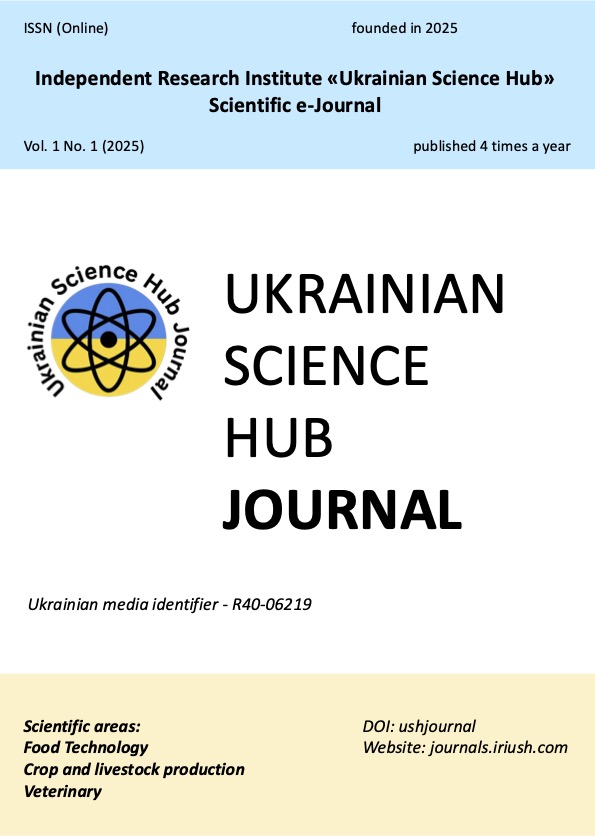RATIONALE FOR STANDARDIZED QUALITY AND SAFETY PARAMETERS OF DELICACY PÂTÉS
DOI:
https://doi.org/10.64378/iriush.journals.2025.1.2Keywords:
technical specifications, production, safety, quality, regulatory frameworAbstract
The food industry of Ukraine is undergoing active transformation, driven by growing consumer demands and the need for harmonization with international standards. Against this backdrop, the development of Technical Specifications of Ukraine (TU U) for delicacy pâtés has strategic importance, as it allows enterprises to formalize quality and safety requirements aligned with Ukrainian legislation, the Codex Alimentarius, and EU regulations. The article provides an analytical review of standards (microbiological criteria, labeling, hygiene) and substantiates measurable quality indicators for pât é s: moisture ≤ 70.0% (optimum 66 – 68%), fat 18.0 – 28.0% (optimum 20 – 25%), protein ≥ 10.0% (optimum ≥ 12.0%), salt 1.2 – 1.8%, pH 5.7 – 6.4, water activity (a_w) ≤ 0.98, starch ≤ 5.0%; sodium nitrite: added ≤ 120 mg/kg (sterilized ≤ 82 mg/kg) and residual ≤ 25 – 50 mg/kg. For ready-to-eat products, the following requirements are established: Listeria monocytogenes – “ not detected in 25 g” during the shelf life; Salmonella spp. – absent in 25 g; total aerobic mesophilic count ≤ 1×10⁵ CFU/g; E. coli ≤ 10 CFU/g; coagulase-positive staphylococci ≤ 10² CFU/g. The discussion compares scientific evidence on risks (Clostridium botulinum, C. perfringens, Bacillus cereus, Listeria) with data on the effectiveness of control measures (nitrite, rapid chilling, thermal regimes, GHP/HACCP). The potential of recipe innovations (use of plant raw materials/game meat, fiber enrichment, fat reduction) is highlighted as a tool to enhance nutritional and biological value without compromising sensory quality. The proposed TUU structure (10 sections) systematizes requirements, simplifies audits and certification, and strengthens competitiveness and export readiness of producers.References
Antoniv, A., & Adamchuk, L. (2024). Investigation of technological parameters of manufacturing meat products from chicken fillet. Animal Science and Food Technology, 15(2), 9-22. doi: 10.31548/animal.2.2024.09.
Bilko, N. V., & Adamchuk, L. O. (2024). Principles of Developing Technical Conditions for New Products. Retrieved from https://elartu.tntu.edu.ua/bitstream/lib/45707/1/Збірник%20праць%202024.pdf#page=278
Commission Decision (EU) 2024/1225 of 30 April 2024 concerning national provisions notified by Denmark on the addition of nitrite to certain meat products. https://eur-lex.europa.eu/legal-content/EN/TXT/PDF/?uri=OJ%3AL_202401225&utm_source=chatgpt.com
Davidescu, M. A., Panzaru, C., Ciobanu, A., Madescu, B. M., Bolohan, I., Porosnicu, I., & Usturoi, A. (2024). Analysis of quality of turkey pâté: organoleptic, physicochemical and microbiological evaluation. Scientific Papers Animal Science and Biotechnologies, 57(2), 170-175.
Hashchuk, O. I., Moskalyuk, O. E., Medianyk, M. O., & Lipinskyi, K. A. (2022). Prospects for the development of innovative formulations of pates as complete products of health nutrition. Retrieved from https://dspace.nuft.edu.ua/server/api/core/bitstreams/cd76fb4b-7d1c-4c53-be77-0aa114df5657/content.
Isaković, S., Karahmet, E., & Toroman, A. (2021, September). Testing of physico-chemical and sensory properties of pate. In 31st International Scientific-Expert Conference of Agriculture and Food Industry (p. 106).
Jenson, I., & Sumner, J. (2012). Performance standards and meat safety—Developments and direction. Meat Science, 92(3), 260-266. https://doi.org/10.1016/j.meatsci.2012.04.015
Kapustyansky, S. V., & Tkach, N. I. (2020). Improvement of liver pate technology through the use of carotene-containing raw materials. Retrieved from http://dspace.puet.edu.ua/bitstream/123456789/8136/1/Магістерська%20Капустянський%20на%20репозитарій.pdf
Manap, K., Serikkyzy, M. (2022). Production of ostrich meat pâtés: Design of a food safety management system. Food Science and Technology International, 29(8):847-856. https://doi.org/10.1177/10820132221124195
Medvedyuk, D. O. (2024). Improvement of the method of production of pate for health purposes using germinated lentil and buckwheat grains. Retrieved from https://dspace.nuft.edu.ua/server/api/core/bitstreams/7a8fed27-1474-446f-9981-34209454a939/content
Poumeyrol, G., Rosset, P., Noel, V., & Morelli, E. (2010). HACCP methodology implementation of meat pâté hazard analysis in pork butchery. Food Control, 21(11), 1500-1506. https://doi.org/10.1016/j.foodcont.2010.03.017/
Prylipko, T. (2019). Quality Control, Safety of Raw Meat and Turkey Meat Pate and Justification of Recipes and Sterilization Regimens. Podilian Bulletin: Agriculture, Engineering, Economics, 1(31), 23–29. https://doi.org/10.37406/2706-9052-2019-2-3
Rupa, T. A., & Israelyan, V. M. (2024). Improvement of the Technology of Pates from Non-Traditional Raw Materials. Scientific Achievements in Solving Actual Problems of Production and Processing of Raw Materials, Standardization and Food Safety: Collection of Papers on the Results of the XII International Scientific and Practical Conference of Scientists, Postgraduates and Students (Kyiv, April 18, 2024 – April 19, 2024). Kyiv: RVV NUBiP of Ukraine, 456 p.
Seleznyova, О. І. (2021). Expansion of the range and improvement of pate technology from non-traditional raw materials. Retrieved from https://dspace.nuft.edu.ua/server/api/core/bitstreams/f6df4841-f98a-4cf3-bf88-8a3501f3ad9d/content.
Skvirenko, E. Y. (2025). Introduction of innovative technologies for the production of pates using edible flour for establishments HoReCa. https://dspace.nuft.edu.ua/server/api/core/bitstreams/37d31cb9-8b91-44fd-8355-ddf830a53d26/content.
Trindade, P. C. O., Santos, B. A. d., Hollweg, G., Correa, L. P., Pinton, M. B., Padilha, M., Payeras, R. H. Z., Rosa, S. C., Cichoski, A. J., & Campagnol, P. C. B. (2023). Pea Protein Isolate as a Meat Substitute in Canned Pork Pâté: Nutritional, Technological, Oxidative, and Sensory Properties. Foods, 12(18), 3486. https://doi.org/10.3390/foods12183486.
Downloads
Published
Issue
Section
License

This work is licensed under a Creative Commons Attribution-NonCommercial-ShareAlike 4.0 International License.


